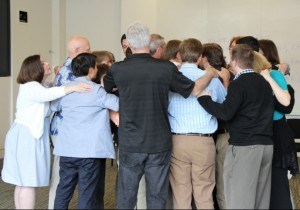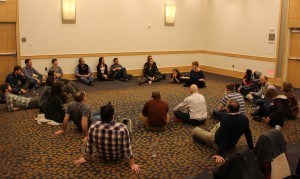The Role of Arts in Sustainability Leadership
August 1, 2014
By: CLiGS
What do a scientist, a policy analyst, and a park ranger have in common?
Each of them needs to cross boundaries and connect in meaningful ways with others. That common need is the basis for a new approach to leadership communication training being used in the Executive Master of Natural Resources (XMNR) program at Virginia Tech’s Center for Leadership in Global Sustainability (CLiGS) in Arlington, Virginia. The interdisciplinary program, which lasts 14 months, places a high degree of emphasis on leadership and management skills to advance local, regional, and global sustainability goals.
Patricia Raun, long-time actor and director of the School of Performing Arts & Cinema at Virginia Tech, leads XMNR participants through exercises and introduces them to ways of thinking that would commonly be found in a theatre rehearsal hall. Raun, whose work is inspired by her affiliation with the Alan Alda Center for Communicating Science at Stony Brook University, also also teaches these skills and processes to other Virginia Tech graduate programs at the main campus in Blacksburg, VA.

“I am a firm believer in the power of play,” Raun notes. “I think even the most intellectual among us learns best by experiencing.”
Actors work to refine their abilities to connect with other people through story, improvisation, and deep listening, she explains. “Actors seek to be vulnerable, accessible, and empathetic. They seek to motivate change through emotion and metaphor.”
These same tools can help sustainability leaders do their work more effectively, Raun says. “We’re using acting exercises with XMNR participants to help them establish direction, alignment, and commitment to the important work they do in the sustainability arena.”
The students participate in leadership communication exercises that ignite their imaginations, teach relaxation skills, heighten their powers of observation, and help them access their ability to concentrate. They gain a more agile facility with the everyday tools of human interaction, including tone of voice, body language, and written and spoken words, through readings, discussions, exercises, and improvisation.
Master’s students in the program notice that practicing these unexpected approaches lessens the discomfort they feel in spontaneous interaction.

“This work really gives me an understanding of what is required to be fully expressive, and I’m increasingly aware of how important that is when I need to communicate with anyone,” noted Aurora Swanson, alumna of XMNR Class of 2013-2014. “In some ways leadership is all about communication – and this work is about approaches to connecting with others that I have never really thought about before. It is really invigorating.”


